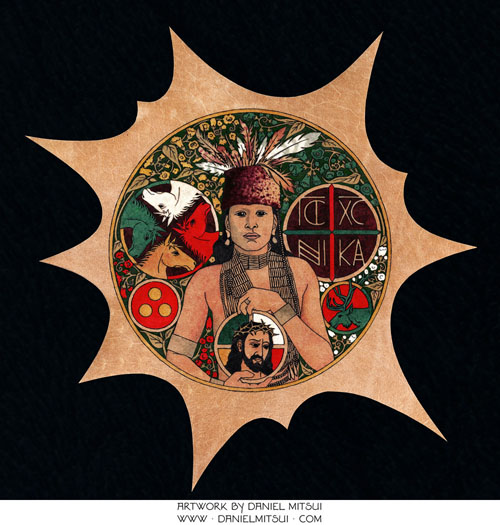
Black Elk was born into an Oglala Lakota family some time in the 1860s. At the age of nine, during a bout of illness, he experienced a great supernatural vision, in which he encountered, among many other things, troops of horses of different colors corresponding to the cardinal directions, a sacred teepee with a rainbow for a door, six grandfathers bearing mystical gifts, a hoop of peoples crossed by red and black roads, and a healing herb bearing flowers in four colors.
He became a highly regarded holy man and healer among his people. Among the many events of his remarkable life, he fought in the Battle of Little Big Horn, toured Europe with Buffalo Bill’s Wild West, participated in the Ghost Dance, and witnessed the massacre at Wounded Knee. During the Ghost Dance, he experienced another vision, in which he saw a messiah with wounded hands standing before a flowering tree.
Black Elk was baptized as a Catholic in 1904, shortly after the death of his first wife. He took the name Nicholas. He fathered six children, three by his first wife and three by his second, all of whom he raised as Catholics. Starting in 1907, he served as a catechist for the Jesuit mission. His duties included preaching, writing pastoral letters, teaching religious instruction, and serving as a spiritual advisor, particularly when the ordained clergy were unavailable. His work helped to lead more than 400 people to baptism.
Nicholas was notable for seeing no contradiction between Lakota culture and Catholicism, regarding the former, in his catechetical instruction, as analogous to the Old Testament. This magnanimous consideration of the two traditions stood in contrast to the forced Europeanization that characterized so many of the missions to Native Americans.
Near the end of his life, Black Elk recounted his mystical visions and his early life to the poet John Neihardt, who revised and published them under the name Black Elk Speaks. This book was widely read and influential, and is considered a classic text of Native American spirituality. However, it did not discuss at all his life between 1890 and 1930, and failed to mention his embrace of Christianity or his work as a catechist. It was in part to correct a widely held but incomplete understanding of Nicholas Black Elk that some of his descendants requested that a cause for his canonization be opened. He was declared a Servant of God in 2017.
In my drawing of Black Elk, I chose to portray him as a young man, basing the figure on a photograph taken around 1886. I chose also to make the drawing circular, since he had spoken at length about the symbolic importance of the circle in Lakota thought, lamenting the transition from life in teepees to life in orthogonal buildings. I drew it on an irregularly shaped piece of brown calfskin.
The emblems in the drawing combine imagery from Black Elk’s visions with traditional Catholic symbols. The circle with the four horse heads represents the cardinal directions: red for east, white for north, black for west, and yellow for south. In earlier illustrations of Black Elk’s visions made by his friend Standing Bear, a dark blue paint was used to represent black; I also have done this. The white color I made by scraping away the top layer of the calfskin. I placed these same four colors in the cruciform halo in the icon of Jesus Christ that Black Elk holds.
The other large circle includes the hoop of peoples, with its red road of goodness running from north to south, and the black road of troubles running from west to east. I combined this emblem with the nomen sacrum of Jesus Christ. The two smaller circles represent Nicholas Black Elk’s two names. The three gold balls on a red background are a traditional symbol of St. Nicholas of Myra. The other contains a literal black elk.
Surrounding the central figure and the emblems, I drew an herb with flowers in four colors: red, yellow, blue and white. This represents the herb of healing that Black Elk saw in his visions, and later discovered.
Medium: Drawing, color ink on calfskin vellum
Dimensions: irregular, ~10" wide
Year: 2024
The original drawing was made on private commission.
Open-edition giclée prints of this drawing are available. You may use the buttons below to pay via PayPal, debit card, or credit card. Be sure to confirm the shipping address.
|
Actual size art print: $75
|
20" × 20" large print: $150
|
200dpi digital download: $15

|
See this page for additional ordering instructions and general information. If you want to pay via a check or money order, please e-mail me at danielmitsui@danielmitsui.com.
